Tacoma Narrows Bridge history - Community connections - Creating the Narrows
Success: Creating the Narrows Bridge 1937- 1940
What's here?
- Factors for success
- A strategic and military necessity
- The money comes - With strings attached
- Economic value
- Loved by locals from the beginning
- One worker died
- July 1, 1940 - Official opening
- The tale of traffic and tolls
- Baby brother of the golden gate bridge
- "Galloping Gertie" earns her name
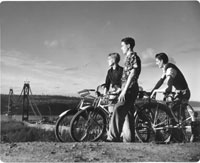
Three boys on bicycles watch bridge in process, February 1940. The copyright in this image is the property of the Tacoma Public Library. Any additional copies or reproduction of this image are prohibited. All rights reserved
Factors for success
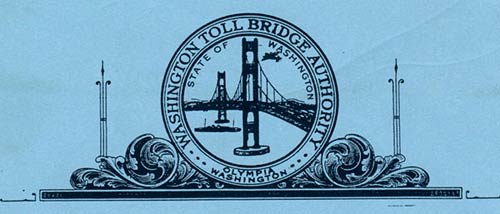
The State Toll Bridge Authority used the Narrows Bridge in its logo, 1938 WSA, WSDOT records
"Can it pay for itself?" From the very beginning, that key issue determined whether there would be a bridge over the Narrows. Private bridge developers believed that traffic volume would be too low. There would not be enough revenue from tolls to pay for construction costs. The Public Works Administration and the Reconstruction Finance Corporation were skeptical.
The Great Depression proved no friend to promoters of a Narrows Bridge. The economic downturn limited financial options and stifled interest in new ventures. To almost everyone the venture seemed "impractical."
So, what changed? Why did the bridge get built?
By the late 1930s several factors came together that brought funding to the bridge. Finally, the Tacoma Narrows Bridge began to move from dream to reality.
In January 1937 the Washington State Legislature passed a law creating the Washington State Toll Bridge Authority (WSTBA). The legislature patterned the bill on California's law that led to the Golden Gate Bridge and others. The legislature appropriated $25,000 to study the Tacoma-Pierce County request for a bridge at the Narrows. Pierce County transferred its application for constructing a bridge to the WSTBA.
By this time, national and international events were affecting plans for the Narrows Bridge.
A strategic and military necessity
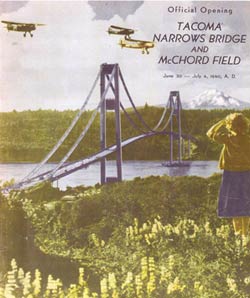
"Official Opening, Tacoma Narrows Bridge and McChord Field, June 30-July 4, 1940" WSA, WSDOT records
The 1940 Narrows Bridge was built "primarily as a military necessity" to link McChord Air Field south of Tacoma and the Puget Sound Navy Shipyard in Bremerton. This important fact is often is often overlooked today. But, it was well known to area residents and local newspapers in 1940.
Successful funding for a Tacoma Narrows Bridge was closely linked with the nation's defense strategy in the late 1930s. In particular, McChord Air Base became a catalyst and ally in the fight to get a Narrows span.
McChord Airfield began as a municipal airfield in the late 1920s. The City of Tacoma purchased 900 acres for an airport, and "Tacoma Field" opened in early 1929. The United States Army became interested in Tacoma Field as a defense base for the Northwest. By 1934 the airport was one of the largest in the western United States. Then, Congress authorized the establishment of airfields in six strategic areas of the country. Tacoma Field became the site for the Pacific Northwest. Ownership passed to Pierce County.
Now, Narrows Bridge proponents had strong support from the United States Navy, because of its shipyard in Bremerton, and the Army, because of its installations at McChord Field and Fort Lewis.
On May 5, 1938 the Governor of Washington officially authorized the transfer of Tacoma Field to the federal Government, and it became "McChord Field." That summer, construction on the $5 million project began on a large scale. By 1939 the Air Corps facility included two runways, four airplane hangars, a 1,285-man barracks, a radio transmission building, a heating plant, a hospital, and warehouses, plus facilities and buildings for maintenance, heating, water, fire, and electricity. In late June 1940, the first bombers (B-18, B-18A and B-23) began to arrive.
War and worries of war after 1935 played a role in the climate that helped create funding for the Narrows Bridge. Japan invaded China, and fascist Italy invaded Ethiopia. With the rise of Nazi Germany after 1933 under Adolf Hitler, war clouds began to gather over Europe. The Nazi government launched a massive military build up. In February 1938 Hitler appointed himself commander of the German army. One month later, the Nazis marched into Austria, then within months took the Sudetenland.
The Roosevelt Administration quietly bolstered its military by funding a major re-armament program. At the same time, the administration poured millions of dollars into public works projects, including roads, dams, and bridges.
On May 5, 1938 (two months after Germany took over Austria), City of Tacoma officials transferred Tacoma Field to the federal government. Two weeks later, on May 23, 1938, the WSTBA submitted an amended application to the federal PWA and applied to the RFC for a loan to build a suspension bridge across the Tacoma Narrows. The revised application included a preliminary design by State bridge engineer Clark Eldridge. Eldridge's plan was "a tried and true conventional bridge design." The State estimated the cost at $11 million.
The 1940 Narrows Bridge and McChord Field held their official opening on the same day. With the bridge connecting the field and Ft. Lewis with the Bremerton Naval Shipyard, the nation's defenses were an important step closer to being prepared for war.
The money comes - With strings attached
On June 23, 1938 the Public Works Administration granted funds for the first Tacoma Narrows Bridge. It marked the culmination of over 14 years of community efforts.
The full story behind this event is not well known. Federal authorities had been skeptical for several years about whether tolls on a Narrows span could generate enough revenue to repay a loan. But, now eastern engineers entered the picture.
According to Clark Eldridge, "eastern consulting engineers" went to the PWA and RFC and said that the bridge could be built for much less than the $11 million Eldridge's design would cost. By "eastern consulting engineers," Eldridge meant the noted and nationally prominent New York bridge engineer Leon Moisseiff. The message fell on willing ears.
Federal authorities made the award, but the money was less, only $6.4 million. And, it came with strings attached. They required the State Toll Bridge Authority to hire outside consultants for the bridge design. Those outside consultants, Clark Eldridge later claimed, were mandated by the Public Works Administration. He put it in simple words. "We were told we couldn't have the necessary money without using plans furnished by an eastern firm of engineers, chosen by the money lenders."
The State Toll Bridge Authority reluctantly agreed. Leon Moisseiff of New York became the consultant hired to design the superstructure (towers, cables, etc.). The firm of Moran & Proctor of New York became the consultants hired to design the substructure (piers).
When Moisseiff's design arrived at the Washington State Highway Department in Olympia, the agency's engineers protested. The state's experts called Moisseiff's plan "fundamentally unsound." The design made the Narrows Bridge lighter and narrower than any bridge ever built, they said, "in the interests of economy and cheapness."
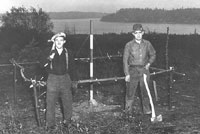
Groundbreaking—start of construction, November 23, 1938 WSDOT
Nevertheless, the project went forward. On September 27 the state opened construction bids. The Pacific Bridge Company submitted the low bid for building the Tacoma Narrows Bridge in the amount of $5,594,730. The associate contractor for supplying steel was the Bethlehem Steel Company. John A. Roebling Sons Company of New York supplied the wire. The design consultants, Moisseiff's firm and Moran & Proctor, divided the standard architect fee of 2-1/2 percent of the construction cost, amounting to $139,868.
November 23, 1938 was a day for Tacoma and Peninsula residents remember. Construction started on first Narrows Bridge. The official "start date" according to the construction contract was two days later, November 25.
Economic value
Completion of the bridge led directly to the development of land in the region for new homes and businesses. Farm acreage also increased, as farmers could more easily get crops to the larger urban markets in nearby Tacoma and Seattle.
The area's population had begun to grow when construction began too. Timber companies found they had ready access to the wealth of great trees on the Olympic Peninsula. And, there were some mineral resources that could more easily be exploited with a quicker route to Tacoma's industrial center.
The tourism and recreation industries benefited enormously from spanning the Narrows. Civic leaders on both sides of the water hailed the positive economic impacts of The Narrows Bridge. The bridge formed a closer link between the state's great federal parks, Mount Rainier National Park and Olympic National Park (created in 1939). Thus, the bridge acted like a magnet, opening up new recreation opportunities for local residents as well as tourists.
Loved by locals, from the beginning

Three boys on bicycles watch bridge in process, February 1940. The copyright in this image is the property of the Tacoma Public Library. Any additional copies or reproduction of this image are prohibited. All rights reserved
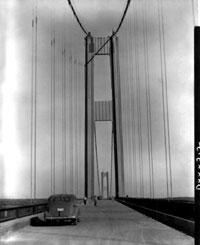
Car drives on nearly finished 1940 bridge, late June 1940
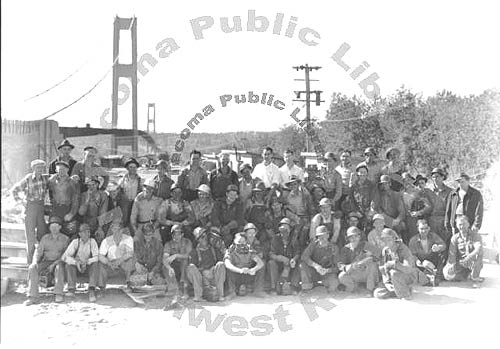
Construction workers gather for portrait with 1940 bridge in background, June 28, 1940. The copyright in this image is the property of the Tacoma Public Library. Any additional copies or reproduction of this image are prohibited. All rights reserved
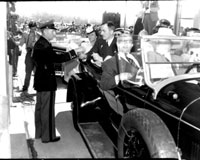
Opening day, July 1, 1940 with Governor Clarence D. Martin paying the first toll. The copyright in this image is the property of the Tacoma Public Library. Any additional copies or reproduction of this image are prohibited. All rights reserved
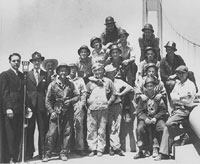
CBS correspondent Edward R. Murrow (second from left) and workers celebrating opening of the Narrows Bridge, July 1, 1940
GHPHSM, Bashford 2709
On Sundays during the construction of the 1940 Narrows Bridge, many area residents would pack a picnic basket and find a spot overlooking the site where they could watch the bridge's progress.
On January 10, 1940 cable spinning began. This novel feature of suspension bridge construction attracted many sightseers. By the first week of May, bridge workers completed the steel floor system. They began to notice that the bridge "bounced." By June 1940 workmen finished concrete pouring for the roadway. The July 1 opening day rapidly approached.
One worker died
Only three days before the Narrows Bridge officially opened, tragedy struck. On June 27, 1940 a workman suffered the first and only death during construction. Fred Wilde, a carpenter, stumbled and fell 12 feet. Oddly enough, on the very next day, a painter fell off the bridge and survived.
July 1 - Official opening
"A dream come true," they said on July 1, 1940. The day brought clear blue skies and a crowd estimated at 7,000 people to the bridge for the official dedication and opening festivities.
Governor Clarence D. Martin conducted ribbon-cutting ceremonies. Then, National Guard soldiers fired a 19-gun salute. Politicians and citizens praised the bridge's beauty and proclaimed the military and economic benefits sure to follow. The Governor paid the first toll and his car sped across the bridge. Parades with marching bands and floats held in Tacoma, Gig Harbor, and at McChord Field celebrated the events with great fanfare.
"Everyone marveled," historian Murray Morgan wrote later, "at the gossamer grace of a structure so long." The third-longest suspension bridge in the world featured a main span of 2,800 feet. Only the Golden Gate Bridge in San Francisco (completed in 1937 with a center span of 4,200 feet) and the George Washington Bridge in New York City (completed in 1931 with a center span of 3,500 feet) surpassed the Tacoma Narrows Bridge in 1940.
The streamlined ferry Kalakala, built in 1935, also participated in bridge-opening festivities. The Kalakala held the honor of making the very last ferry run across the Narrows on July 2, 1940. Over 1,400 people made the voyage that stopped at Point Defiance and Gig Harbor. They celebrated for hours with music and dancing sponsored by the Young Men's Business Club of Tacoma.
Edward R. Murrow, the well-known CBS correspondent, attended the opening ceremonies. Murrow was also the brother of the State Highway Department Director, Lacey Murrow.
The tale of traffic and tolls
Tolls on the 1940 Narrows Bridge were necessary to repay the loan from the RFC that had helped build the span. Residents on both sides of the Narrows wanted the bridge, but the tolls were controversial.
The problem was that it cost motorists more to cross the Narrows using the bridge than by the old ferry service. The fare for car and driver was $.75 each way ($1.50 round trip), and 10 cents for pedestrians.
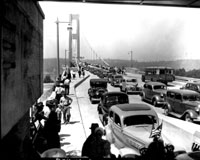
On opening day, July 1, 1940 over 2,000 vehicles crossed the bridge. The copyright in this image is the property of the Tacoma Public Library. Any additional copies or reproduction of this image are prohibited. All rights reserved
Traffic across the bridge quickly surpassed all expectations. Local citizens (and the State Toll Bridge Authority) thought the new bridge would bring a population boom and boost the area's economy. But, actual use dramatically exceeded their highest hopes. On opening day, some 2,000 cars crossed the bridge.
Traffic was more than triple the figures projected by surveys. Soon, the number of vehicles crossing reached 145% higher than earlier ferry traffic. In 1939 the ferry service had carried 205,842 vehicles across the Narrows, an average of 564 per day. In the first four months after the Narrows Bridge opened (July-October 1940), some 1,661 vehicles a day paid the toll and crossed. The four-month total of 265,748 vehicles was more than had used the ferries during the entire 12 months of 1939.
Because traffic—and, therefore, revenues—greatly exceeded all expectations, Toll Bridge Authority reduced the commuter toll. Two months after that, the Authority refinanced the bridge bond issues and reduced the basic toll by another 5 cents.
"Baby Brother" of the Golden Gate Bridge
Some called the 1940 Narrows Bridge the "baby brother" of the Golden Gate Bridge, completed in 1937. It was similar in "style of structure" to the bigger San Francisco span, but was built with far less steel. The Narrows Bridge was built to withstand a wind of 120 mph, projected to cause a 20-foot deflection, or sideways movement, of the deck. In contrast, the heavier and wider Golden Gate Bridge had a 13.5-foot deflection capability.
"Galloping Gertie" earns her name
Even in a light breeze, the Narrows Bridge moved. Suspension bridges are supposed to move. But, this was different.
The roadway sometimes "bounced" or "rippled" in a wind of 3 or 4 miles per hour. Often, several waves of 2 to 3 feet (and on a few occasions up to 5 feet) would move from one end of the center span the other. There seemed to be no correlation between the wind speed and the size of the waves. Sometimes the span would "bounce" for a few moments then stop. Other times, the waves lasted for 6 or even 8 hours.
Thrill-seekers drove to the Narrows from miles around when the ripples started. Some motorists became "seasick" and avoided using the bridge. But, for adventurous spirits the bridge became an amusement ride. Drivers crossing the span at times saw a car in front of them suddenly disappear into the trough of a wave. Moments later it reappeared as the roadway rose. According to one report, a couple of times drivers experienced waves 10 feet high.
What was that motion? In the first weeks after the bridge opened, the newspapers referred to its movement as "the bounce" or "the ripple." Here are other terms used to describe the movement, used by a variety of locals, engineers, and other observers:
- Gallop
- Wave
- Undulation
- Up and down
- Crests and troughs
- Peaks and valleys
- Rising and falling
- Like a roller coaster
- Vertical oscillation
- Vertical flexibility
How did she get her name? Only later, in the autumn of 1940 about the time of the collapse, did the nickname "Galloping Gertie" make it into the newspapers.